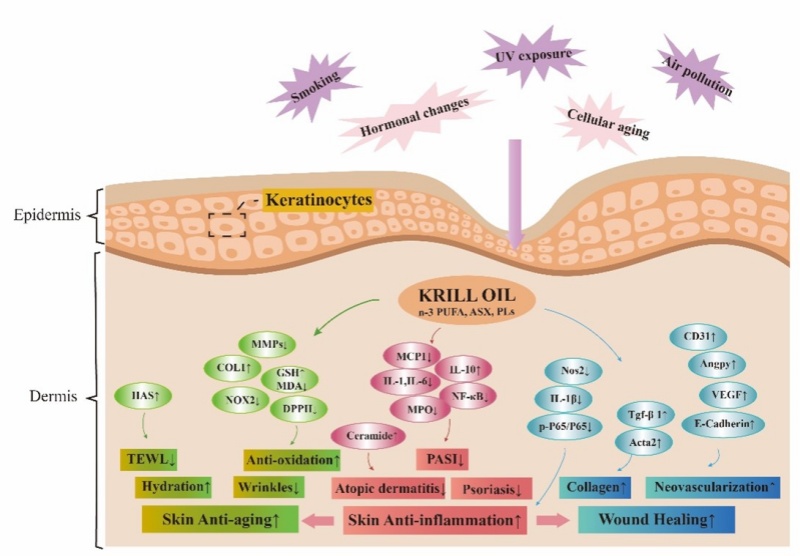A Review on Nutraceutical Potential of Krill Oil in Skin Health and Disease
Krill oil (KO), obtained from Antarctic krill through a series of processing and purification techniques, is rich in nutrients, primarily omega-3 polyunsaturated fatty acids (n-3 PUFAs), phospholipids (PLs), astaxanthin (ASX), vitamins, flavonoids, and other minerals. Research has found that KO has strong antioxidant and anti-inflammatory properties, playing a significant role in metabolic regulation, neuroprotection, and balance of the gut microbiota. Moreover, due to its unique lipid structure, KO was absorbed more effectively by human body, in which its utilization rate was improved. As a high-quality lipid resource, it has been widely used in dietary supplements in recent years.
Recently, the Health and Functional Food Department from CAS Engineering Laboratory, Shanghai Institute of Nutrition and Health, Chinese Academy of Sciences published a review article in Frontiers in Nutrition on July 12, 2024 entitled “Krill oil: nutraceutical potential in skin health and disease”.
This article systematically discussed the research progress of krill oil (KO) in skin health management, focusing on its ability to combat skin aging, eliminate skin inflammation, and promote wound healing, demonstrating the improvement effects of krill oil and its main components on various skin issues and diseases.
Skin health relies on adequate nutrition. Studies have shown that natural active substances extracted from natural herbal plants, marine organisms, etc., have the advantages of being more naturally pure and less allergenic when compared to chemically synthesized cosmetics. Unlike traditional topical treatments, oral intake of some active substances can also enhance skin health. With the growing demand for natural solutions to skin anti-aging and inflammation, KO demonstrates potential in alleviating skin aging and enhancing overall skin health and vitality. Cellular, animal, and clinical trials have confirmed that KO and its main components can improve skin dehydration, reduced elasticity, wrinkle formation, and other signs of skin aging induced by internal and external factors. This is achieved by downregulating matrix metalloproteinase gene expression, reducing collagen degradation, and upregulating hyaluronic acid receptor expression. By strengthening the stratum corneum lipid barrier and maintaining proper intercellular lipid balance, KO can alleviate symptoms of erythema, edema, itching, and skin thickening caused by atopic dermatitis, psoriasis, and ultraviolet radiation. Furthermore, it promotes cell proliferation and angiogenesis by improving fibroblast function and repairing damage to endothelial vasculogenesis, which in turn facilitates wound healing. As carriers, phospholipids in KO can better penetrate cell membranes, thereby promoting absorption by the human body and increasing bioavailability.
To meet the "Healthy China" initiative, the Health and Functional Food Department of the CAS Engineering Laboratory is committed to provide innovative resources and technical support to promote the development of nutrition and health industry. By focusing on the development of nutritional intervention products for metabolic diseases, cardiovascular diseases, tumors, and nervous system diseases, the department conducts R&D of products and technologies, functional evaluation and industrial services, as well as clinical trials and promotion of nutrition intervention products.

Krill oil has protective effects on skin health, including anti-aging, anti-inflammatory, and promoting wound healing. (Image by CAS Engineering Laboratory for Nutrition)
Media Contact:
WANG Jin
Shanghai Institute of Nutrition and Health,
Chinese Academy of Sciences
Email: wangjin01@sinh.ac.cn
Web: http://english.sinh.cas.cn/
